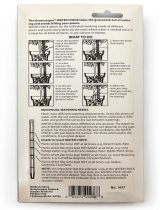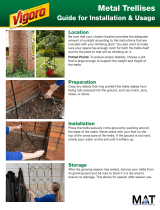Page is loading ...

GO TO BONNIEPLANTS.COM FOR MORE TIPS ON VEGETABLE AND HERB GARDENING
HOW TO GROW WiTH
FIRST THINGS FIRST. Your plants may arrive dry and thirsty. Give
them a drink, watering until the pot turns dark brown. Keep plants in
a bright spot protected from cold, and plant after the last frost. Follow
planting directions on the pot label or see the video at bonnieplants.com/
growing/growing-tomatoes.
TOMATOES
PLANTING
Tomatoes run on warmth. Plant in late
spring or early summer, after all potential
for the last frost has passed. In zone 10,
tomatoes can be treated as a fall and
winter crop as well.
Find a sunny spot. Tomatoes need at
least 6-8 hours of sun to bring out their best
flavors, and you will need to stake, trellis,
or cage most varieties to keep them off the
ground. Install your supports when you set
out your plants. Space plants at the dis-
tance indicated on the stick tag in the pot.
Prepare the soil. Tomatoes need a
constant supply of nutrients, and take them
up best when the soil pH ranges from
6.2 to 6.8. Add at least 3 to 4 inches of
compost to your beds or containers to help
hold moisture and contribute nutrients to
the soil to be used as needed by the plants.
Plant deeply—very deeply. Plant so
that two-thirds of the stem is buried. This al-
lows roots to sprout along the buried stem,
making your tomato plant stronger and
better able to find water in drought. Note
that tomatoes are the only vegetables that
should be planted this way.
Mulch well and water regularly.
Whether you’re planting in the ground,
raised beds or containers, cover the soil
with 2 to 4 inches of mulch, straw, or
shredded leaves to discourage weeds and
keep the soil evenly moist – the key to
preventing cracked fruits and blossom-end
rot. Water regularly, aiming for an inch
per week (more in hot weather). If desired,
use soaker hoses or drip irrigation to help
maintain even soil moisture.
Try growing in containers. To-
matoes are easy to grow in a pot if you
use a big container (18 to 24 inches in
diameter). Fill it with premium quality pot-
ting mix and mix in some compost. Use a
tomato cage in the pot for taller varieties,
or a stake for smaller patio types. Be sure
to plant deeply and keep the soil moist.
FERTILIZING
Feed regularly with Bonnie Herb, Veg-
etable & Flower Plant Food to keep plants
healthy and vigorous. Your plants will love
the naturally based formula made from
oilseed extract. Apply every 1 to 2 weeks,
following the label directions.
By late summer, plants that began
producing early in the season will show
signs of exhaustion. Coax out new growth
by pruning away withered leaves and
branches. Then follow up with plant food
and treatments for leaf diseases or insects,
if needed.
TROUBLESHOOTING
As summer heats up, some tomato plants
have trouble setting fruit. Be patient, and
you will start seeing little green tomatoes
again when nights begin cooling down.
Meanwhile, promptly harvest ripe tomatoes
to relieve stressed plants of their burdens.
Humid weather creates ideal conditions
for fungal diseases like early blight, which
causes dark spots to form beginning on
lower leaves. Late blight is a more devastat-
ing disease that kills plants quickly. Protect
against it by spraying the leaves with an
approved fungicide such as chlorothalonil
(not organic) or copper (organic)—be sure
to follow label directions—and keeping the
garden clean of plant debris.

GO TO BONNIEPLANTS.COM FOR MORE TIPS ON VEGETABLE AND HERB GARDENING
HOW TALL WILL THEY GROW?
Determinate (including bush)
varieties reach a certain plant height,
usually 3-5 feet, then stop growing.
The majority of their fruit matures
within a month or two. These are
popular with gardeners who like to
can or make sauce, or have another
reason for wanting to harvest most of
their tomatoes at once. Most need a
short cage.
Indeterminate varieties con-
tinue to grow and produce tomatoes
throughout the growing season. These
vigorous plants need extra-tall sup-
ports (at least 5 feet). Because indeter-
minate varieties produce so many
branches, gardeners often prune a
few for optimum-sized fruit, or train
each plant on a very tall trellis.
Look for the words “determinate”
and “indeterminate” on your plant
tags and in the variety descriptions
on our website, bonnieplants.com.
–––––––––––––––––––––––––––––––––––––––––––––––––––
SYMBOLS FOR
DISEASE RESISTANCE
Tomato variety names are often
followed by capital letters that
indicate resistance to certain
diseases. Here’s what they mean:
V – Verticillium Wilt
F – Fusarium Wilt
N – Nematodes
ASC – Alternaria Stem Canker
TMV – Tobacco Mosaic Virus
St –
Stemphylium (gray leaf spot)
TSWV – Tomato Spotted Wilt Virus
LB – Late Blight
–––––––––––––––––––––––––––––––––––––––––––––––––––
RECIPES
Nothing beats a simple sandwich with
fresh tomato slices, but we bet you’ll
have so many tomatoes to harvest
that you’ll need more ideas. Go to
bonnieplants.com/cooking to
view a variety of recipes for your
freshly harvested tomatoes, along
with other veggies and herbs.
Of all crops, tomatoes are the most
likely to get problems, but many hybrids
have been developed that resist the worst
or most prevalent diseases. Check the vari-
ety descriptions on our website for details
on specific disease resistance.
Pests like hornworms eat tomato foliage
and sometimes damage fruits. (One or two
hornworms can strip a plant leafless.) Pick
worms off or spray with DiPel®.
Sometimes a ripening tomato will get a
black, sunken spot on its blossom end. This
is not a disease but a frustrating condition
called blossom-end rot, caused by a cal-
cium deficiency. Help prevent it by increas-
ing soil pH to 6.5 to 6.8, keeping soil
consistently moist, and not over-fertilizing.
If a plant has already been affected, use a
calcium spray on the foliage.
HARVEST & STORAGE
As tomatoes begin to ripen, their color
changes from vibrant medium-green to
a lighter shade, with faint pink or yellow
stripes. These “breakers,” or mature green
tomatoes, can be chopped for salsa, pick-
led, or pan-fried into a crispy appetizer. Yet
tomato flavors become much more complex
as the fruits ripen, so you have good reason
to wait. The exact signs of ripeness vary
with variety, but in general, perfectly ripe
tomatoes show deep color yet still feel firm
when gently squeezed. Store harvested
tomatoes at room temperature indoors, or
in a shady place outside. Never refrigerate
them, as temperatures below 55° cause the
precious flavor compounds to break down.
Bumper crops can be frozen, canned, or
dried for future use.
TOMATOES
LIKE. LEARN. SHARE.
GROW WITH BONNIE PLANTS.
Facebook “f” Logo CMYK / .ai Facebook “f” Logo CMYK / .ai
• ACCESS TO EXPERTS through our Ask an
Expert service
• HELPFUL INFORMATION on how to care for
your vegetable and herb plants
•
ON THE GO? Grow these plants with help
from our free app for iPhone and Android,
Homegrown with Bonnie Plants. Find out more at
bonnieplants.com/app.
BONNIEPLANTS.COM
/










